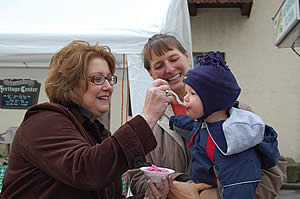
Pickling is a great way to preserve summer’s bounty and add a tangy crunch to your meals. Home-canned pickles are economical–my last batch cost me less than $2/quart, and it would have been even cheaper if I’d grown the cukes myself. They are also free of the high fructose corn syrup, preservatives and artificial colors found in many commercial brands of pickles.
The day a friend introduced me to garlic dill pickles was the day I quit making any other kind. Not only are they the easiest pickle I’ve ever made, they’re delicious as well; a sweet, mild dill that almost everyone seems to like. Our family of six can polish off a jar in one meal–in fact, one child would eat the whole quart herself if I’d let her. (She once requested a jar of pickles for her birthday!)
While many pickle recipes involve long fermentation periods, garlic dill pickles require just an hour or two of your time and simple, fresh ingredients. Warning: you may find them addictive!

Garlic Dill Pickles (makes 6 qt.)
6 qt. cucumbers, washed and sliced about ½- ¾ inch thick
12 peeled garlic cloves
6 fresh dill sprigs
1 large onion, sliced
¾ tsp. alum, divided
2 Tbsp. pickling salt, divided
 Syrup:
2 C. vinegar
2 C. water
3 C. sugar
Wash and sterilize six quart-sized canning jars and lids. Combine syrup ingredients and bring to a boil. Put a slice of onion, 2 cloves of garlic and a dill sprig in each jar. Add sliced cucumbers, packing as tightly as possible. Add 1/8 tsp. alum and 1 tsp. salt to each jar. Fill with syrup, leaving a half-inch of headspace. Seal and process 20 minutes in boiling water bath.
Tips:
- The amount of syrup needed will vary depending how tightly the cucumbers are packed. If you run out, simply mix up another batch.
- For stronger flavor, add more garlic and onion.
- If your dill doesn’t ripen at the same time as your cucumbers, don’t despair—just bag the heads and freeze them for later use. In a pinch, you can substitute a teaspoon of dill seeds instead.
- Let the pickles set for a few weeks or months before using for best flavor. Chill before serving to crisp them up.
- Pickling salt is recommended, although table salt will also work. Pickling salt is free of additives that may cloud or discolor the syrup.
- Some people prefer to use apple cider vinegar; it gives a slightly different flavor and a darker syrup.
- I like to use small cucumbers because I can fit the slices more tightly in the jar (and thus less syrup), but any size cucumbers may be used. Cutting them in spears may allow you to pack large cucumbers more tightly in the jar. Whole cucumbers may also be pickled if desired.
Lisa Amstutz is a freelance writer and editor. She lives on a six-acre hobby farm with her husband, four children and small menagerie of farm animals. Lisa is co-author of Local Choices and author of seven nonfiction picture books.






























This is essentially the same pickling solution used to make pickled herring but a bay leaf and some allspice or peppercorn is added. Good stuff.
[…] I love making garlic dills, this year I decided to do some bread and butter pickles as well. Bread and butter pickles are […]